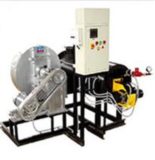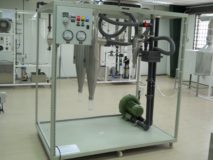Supersonic Wind Tunnel Model AT 012
Home » Products » Supersonic Wind Tunnel Model AT 012
Supersonic Wind Tunnel Model AT 012
Sci-tech Supersonic Wind Tunnel Model AT 012 is a test bed for examining the fluid mechanics and associated fluid phenomena for air travelling faster than the speed of sound. The supersonic wind tunnel is open type wind tunnel working continuously; a variable speed fan is used to draw through the wind tunnel. It draws air from the atmosphere & is after flowing through the wind tunnel the air is discharged back to the atmosphere. In order to increase the speed of air to supersonic conditions, the air is accelerated through a converging-diverging nozzle. In the measurement section, the air is accelerated further and flows around a drag. The air the flows through the diffuser where it is decelerated before entering the air blower. Interchangeable test sections are provided to generate different velocities (Mach 1.4 & Mach 1.8). The trainer supplied with four different test models (Wedge, Double wedge, Rocket, Bullet) For observation of the supersonic flow and the resulting shock fronts, the Schlieren optics system is supplied. Pressure sensors are used to measure pressure distribution, & transmitted directly to an integrated computer using a USB based Sci-CalR Data Acquisition System for analysis using the software.
| Size: | 400cm x 100cm x 170cm (LxWxH) |
| Weight: | 350 kg |
Item Description
Features
- Velocity Range: Subsonic through Mach 1.8 with help of interchangeable Test Section.
- Continuous Operation using Variable Speed Air Blower, working on Vacuum Principle.
- Compressed air collecting tank & air dryer not required (Compared to Intermittent Type Supersonic Wind Tunnel).
- Schlieren Apparatus with accessories for visualization of Flow at supersonic velocities.
- Data Acquisition System for measurement & analysis of test parameters
- Different test models available for study of flow patterns.
Sci-tech Supersonic Wind Tunnel Model AT 012 is a test bed for examining the fluid mechanics and associated fluid phenomena for air travelling faster than the speed of sound. The supersonic wind tunnel is open type wind tunnel working continuously; a variable speed fan is used to draw through the wind tunnel. It draws air from the atmosphere & is after flowing through the wind tunnel the air is discharged back to the atmosphere. In order to increase the speed of air to supersonic conditions, the air is accelerated through a converging-diverging nozzle. In the measurement section, the air is accelerated further and flows around a drag. The air the flows through the diffuser where it is decelerated before entering the air blower. Interchangeable test sections are provided to generate different velocities (Mach 1.4 & Mach 1.8). The trainer supplied with four different test models (Wedge, Double wedge, Rocket, Bullet) For observation of the supersonic flow and the resulting shock fronts, the Schlieren optics system is supplied. Pressure sensors are used to measure pressure distribution, & transmitted directly to an integrated computer using a USB based Sci-CalR Data Acquisition System for analysis using the software
See also different:

Turbo-Charger with Variable Geometry (on base)



